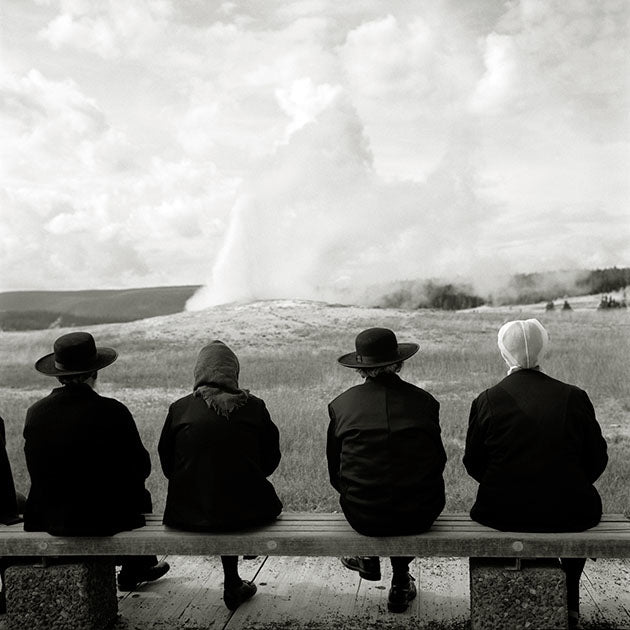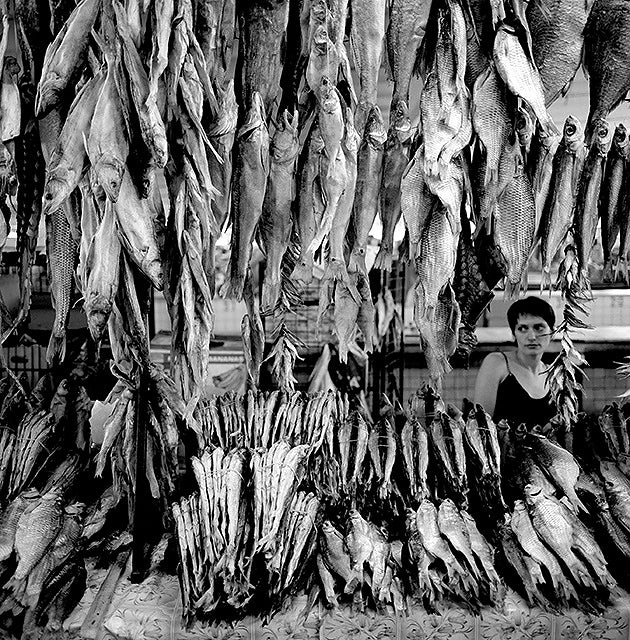Kent Miles is a native of Salt Lake City, Utah who graduated from the Art Center College of Design in Los Angeles. He has worked with the Center for Documentary Arts (CDA) for more than 25 years and was a principal contributor to many CDA exhibit and book projects. In 1987, he was selected as one of the "Top One Hundred New [American] Photographers" by Photography's Annual Awards in New York City, sponsored by Eastman Kodak and Maine Photographic Workshops. He has taught in multiple art centers and universities and now mentors photographers in the Salt Lake Seven. His experience with both film and digital photography and the ease of his style allows for a clean and refreshing look at not only his well-known portraits, but also his landscapes and cityscapes.
KENT MILES, COMBINING IMAGES AND AUDIO
"I am a primarily a documentary portraitist. I shoot Hasselblad. I shoot Rolliflex. I shoot Mamiya and Fuji rangefinders. I shoot Leica SLRs and rangefinders, and I shoot digital depending o the nature of the job, and I even occasionally shoot with a pinhole camera. The camera I use has not been what defines me, but the fact that my principal interest always comes back to documentary portraits. I have a compelling interest in people, places and things as they are, but I hope I see with a degree of grace, wit, and good will. The direction I'm moving now is not just making photographs, but in adding oral history interviews with photographs to create a more meaningful portrait. This is a classic documentary approach. The combination of words and pictures is a deeper exploration into the reality of the person. The camera can only reveal what someone or something looked like during the brief moment of encounter. A person’s words reveal the internal reality of what he or she is thinking and feeling. The trick is that the photograph, the interview, the editing and the presentation all need to be done well.
I am working now with Maggie St. Claire to create documentary projects for corporations, institutions, families, and individuals. These are viable commercial projects as well as compelling personal projects. I continue to work with the Center for Documentary Expression and Art on projects about the ethnic and minority people of Utah. We are currently updating our project Faces and Voices of Refugee Youth that I first shot 10 years ago as a Cultural Olympiad project and has been traveling to Utah schools, libraries and public venues ever since. I have an exhibit at The Leonardo in Salt Lake City of portraits and interviews with amputees who are using modern prosthetic knees, legs and feet. The installation features the technology of Otto Bock, the world’s leader in prosthetic innovation and production.
THE SALT LAKE SEVEN
The Salt Lake Seven is a group of dedicated photographic artists. We have one or two professionals, but most are serious avocational photographers who want to make better photographs. Great things happen when a small group of committed practitioners of any art form gather on a regular basis to show their work and share their ideas. These gatherings become an arena in which creative, technical and philosophical challenges are made and accepted. Ideas are voiced, tried on for size, and kept or recycled. The group becomes a sounding board wherein people who have learned to trust one another respond to the offerings honestly, thoughtfully, fairly, passionately. Criticism is never an attack, merely a response. Therefore, one doesn’t feel threatened. Mistakes become keys that open doors to new possibilities. Successes become validations that build the confidence needed to take greater creative risks. Over time, as part of such a group, it is impossible to avoid growth.
I have seen remarkable growth in the work of each of the members who participate on a regular basis. This seems to be one of the great secrets of success for groups such as this – regular participation. Knowing that your opinion matters to others and that they look forward to see what you have done since the last meeting is a great motivator. The monthly meeting becomes a little deadline. And as we all know, deadlines make the world go round.
We meet one evening a month for three hours. I take the responsibility for leading the discussion and directing critiques. We will go to local exhibits. We produce Blurb® books. I take the lead in finding venues for group shows, making sure the applications are filled out and submitted. Our second show at the Finch Lane Gallery is currently up, we have had three shows at Art Access Gallery, and we have an exhibit that is in the Utah Arts Council Traveling Exhibition program. Individuals have also had their own shows. We are looking for more venues outside of Salt Lake and even outside Utah. I think the group is ready to make the next step. Look for our new group blog which should start up in the next few weeks. SL7 is a way for people to find a sense of community, but also to have a goal. When you realize there is a meeting coming up next Tuesday and you need something to show, it is a good motivator to get working. Each session costs $20 per person. The format seems to work. You can see the results when you see our exhibits. Everyone in the group is producing wonderful images and getting better. We help save each other from our own bad pictures.
Seven was the number of people initially involved in the group, but there are more than seven photographers now. Twelve of us are in the Finch Lane show. We keep "Seven" because the number symbolically suggests fullness or completion. I am considering having a second night to meet so everyone will have a chance to show work and get a fair critique. For those who are interested in joining the group, contact me directly. I will tell them where and when we meet. There is no membership policy, but there is a participation policy. Those who participate in the exhibits are those who come regularly."
FINDING YOUR STYLE
"It's important to understand what style is. It is not the imposition of characteristics upon your work that make it look different than everyone else's work. Style is the emergence of your values. It's the gradual result of saying "yes" to things you care about and saying "no" to things you don't care about. This includes subject matter, content, clients, where you work, and when you work, attention to detail, all of these things. With the passage of time, your values show up in the work that you do. Your imagination shows up. It takes some time for a style to emerge that will really set you apart from the crowd. If you try to shortcut this process just to have something different, then you might be a fad—the flavor of the month—and soon everyone else will copy you. If you find a way to bring your deeply held values into the work you do, then there will be no way that someone else can replicate that. As much as I like Irving Penn, if I try to duplicate his shots, there is no way that I could do work that would be confused for Irving Penn’s because too much of him is in his work. I think the same goes for the kind of work that I do. I don’t have flashy trick or gimmicks. I just have forty years of experience putting the qualities I care about into the photographs I make. I don’t have to worry about someone else copying me because they can’t really imitate all that accumulated experience. What is the old expression? "Good judgement? That comes from experience. Experience? That comes from bad judgement."
If you really want to develop a style, find something that you can pay attention to and come back to over and over again. Maybe it's an apple tree. Keep coming back to it, and make images of it. You look at that tree, maybe in different seasons, different times of day, different weather. You start to see what makes it unique. Then you start extending out from that. You photograph your apples as buds and blossoms, as emerging and ripened fruit. You use your apple tree as a point of departure, and after awhile, because of this process of coming back and looking more deeply at it, you begin to understand it and your photographs become good. Word gets out. "You need pictures of an apple tree? There is this person who really knows apple trees. She can do what you want and you should contact her." Now, that apple tree doesn't have to be the only thing you shoot. You can expand into other areas. But that is how you become good. (This is not necessarily what it means to be successful, which tends to be a commercial evaluation. This is where business experience comes in very handy.)
For me the subject I have come back to again and again and have started to become good at photographing in a particular style is the process of telling a story about people. I like to create photographs in a way that almost feels like making a snapshot, but it's so much more. I like doing photographs that are actually quite difficult but I want to make it look easy. I like to do that with portraits of people. It is what I do with my documentary projects. The portraits I like most seem to have a snapshot aesthetic but they have been raised to a level of fine art in terms of design, compsition, execution, and presentation—they have the whole package. In the end, though, it should feel effortless. The same quality applies when I add interviews to documentary projects. The interview seems to be an informal, intimate conversation, but it is more when it is edited and crafted into something that reads like literature."
PHOTOGRAPHIC CONTRIBUTION
"I'd like to be known as someone who made pictures of people and places that aesthetically gratify people who look at my photographs…and that they survive. I hope they wear well over time and add to the sum of good of the human experience. I hope I can create pictures of people that preserves something authentic about them. I hope their children and grandchildren and great-grandchildren find those pictures beautiful and compelling. I hope my photographs capture and preserve something about a person's life and experience and about who they were. That's what I want to be known for. If I can create a picture of a place that captures an intriguing sense of the possibilities of life, whether the picture is a cityscape, or a landscape, or a portrait. This is something that has lasting value. I would like to create images of lasting value." Check out more of Kent's work on his website.
WHAT'S IN KENT MILES' BAG
Digital: Leica M8, 24mm Elmarit f2.8 Asph, 28mm Sumicron f2 Asph, 35mm Sumilux f1.4 Asph, 50mm f1.4 Sumilux, 75mm Sumilux f1.4 Asph
Fuji X100
Canon 40D with 50mm f/1.4, 17-40mm f/4, 24-105mm f/4, 80-200 mm f/2.8 lens
Film: Favorite B&W film - Kodak TMY 400; Favorite Color Film - Kodak Portra 400
Leica M6, Same lenses as for the M8, plus a few more.
Leica R6-2, R7, R8; 15mm f3.5 to 350mm f4.8
Rolleiflex 3.5F
Mamiya 7, Mamiya 6
Fuji 6x9
Hasselblad 500CM, 50mm f4, 60mm f3.5, 80mm f 2.8, 150mm f4
Hasselblad SWC
Tripods: Gitzo
RELATED ARTICLES
How I Got That Shot - Marc Muench
Focus on Photographers - Nevada Weir
Roadside Photographs - Mesa Arch, Canyonlands




